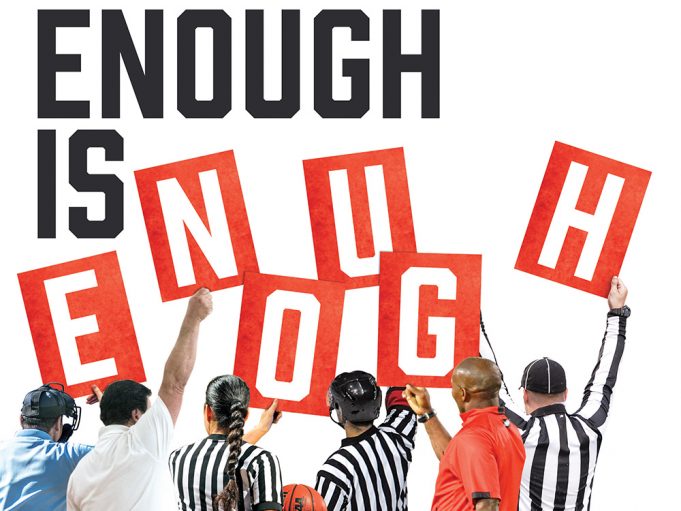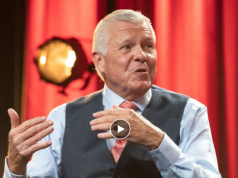“I did not like being a referee one bit, and I’m very happy to be done with it. It was very stressful, and I hated all of it. I will never do it again.”
That’s what my grandson said about his experience as a referee in youth soccer. His is one voice echoing a trend that sports writers like Doug Abrams, an expert in youth sports, have been noticing for years: the exodus of referees from youth games. “Referees,” Abrams writes, “quit in droves each year because they are unwilling to tolerate incessant verbal, and sometimes physical, abuse inflicted by coaches and especially by parents. … An official’s thick skin eventually wears thin, patience with unruliness wanes, and enough is enough.”
My grandson’s departure from the ranks of sports officials is a loss — for him, for the players and for the sport. He became a sports official because he loves sports, especially soccer and lacrosse, both of which he plays well, and because he really likes young kids. He has a good eye. He sees the field, understands the games and can spot the sometimes subtle distinctions between a foul and an unintentional bump that doesn’t affect the ongoing play. He participated happily in the referee-training program and looked forward to having a job in a world he loved. And like so many others, he quit.
Reorganize Attitudes
Is there a solution? Probably not if the efforts focus primarily on the parents. Various psychological factors make it unlikely that the behavior of a sad but dominant minority of parents will ever change: the need to live vicariously through a child, the feeling that a child’s performance reflects the worth of the parents, the high stakes and hopes for college scholarships. The solution is to redefine the relationship between coaches and referees and their responsibilities during games. The strategy is to dramatically reorganize both attitudes and rules. Changing the relationship between coaches and referees could result in a transformative improvement in the culture of youth sports that would ultimately affect the behavior of players and even most parents and, consequently, improve the likelihood of retaining referees.
Too often, the culture of youth sports reflects the culture of professional sports. Young athletes emulate their professional heroes. Violence begets violence; trash talk inspires trash talk; berating the referees breeds berating the referees. Winning becomes the only acceptable outcome, and one of the strategies to secure a win is trying to intimidate the referees — to “get inside their head” in an attempt to influence their calls. The referees are sick of all the abuse, so they adopt a siege mentality and retreat to a defensive posture behind the wall of authority that the current rules provide. “Shut up, coach,” and threats of ejection prevent communication and cooperation.
To end the referee crisis, a real spirit of mutual respect and support must replace the culture and psychology of animosity. The glue that ought to bind the adults in youth sports — coaches, referees, parents — is the overriding goal of protecting kids from serious injuries and, at the same time, helping them develop their skills, learn sportsmanship and deepen their love of the game. That’s the common ground. Improved communication and mutual respect are critical for building healthy new alliances. How coaches and sports officials talk to each other during games matters.
During a game, when infractions occur, four things must happen:
- Referees must make the call, erring on the side of safety.
- Coaches must support the call even if they disagree with it.
- Players must understand that referees and coaches will not tolerate the penalized behavior.
- Parents/fans must see the partnership between coaches and referees.
My grandson recalls a time when he got close to feeling this sort of mutual respect after a difficult call he made during a girls’ soccer game he refereed: “One of the players had a breakaway and was dribbling towards the opposing net. She then got blatantly tripped by a girl chasing her. The trip was in the box, so the coach was screaming at me to blow the whistle and give them a penalty shot. I didn’t call it because when the girl was tripped, the ball kept rolling, and I saw a player rushing in with an open path to the goal. I called, ‘Play on,’ and the girl scored. After that, when I was setting the teams up for the kickoff, the coach supported me. He said, ‘Sorry, ref, great call, good play-on.’”
Imagine the difference if this sort of communication and cooperation became the norm. Instead of watching coaches going berserk over penalties called against their team, fans would see a referee approach the bench and say, “Yes, coach, it was a close call, but I’m erring on the side of caution because the game is getting rough,” and both coaches would nod and warn their players to tone it down.
‘Yeah, right’
Some may dismiss this vision of a paradigm shift in youth sports as a lot of Pollyanna nonsense. And they could be correct. Creating a new dynamic between coaches and sports officials will remain fanciful until the administrators of the various youth leagues codify it in their rulebooks. Current rules fail to establish an equal, respectful partnership between coaches and referees. Instead, sports rely on “codes of conduct” — fairytale wishlists that outline roles and responsibilities. Because these codes — reasonable and desirable as they may be — lack the enforceable clout of rules, they are typically abandoned during the heat of games, and the current rules have failed to prevent an antagonistic culture from infecting sports. Coaches and fans shout obscenities at referees because they have no other recourse, and the referees are walking away because they, too, have no other recourse.
In order to change a culture, new structures must be created that support the desired changes. In the case of youth sports, everyone seems to agree that the primary focus must be player safety. Unfortunately, this agreement is not supported by the rule structure or the usual behavior evident during games. The traditional animosity among coaches, sports officials and fans results in a dangerous environment for players, so new rules must be written — rules that establish coaches and referees as cooperating problem-solvers and responsible adult guardians, not just as the final word in their separate spheres of clashing egos.
Timeout for Player Safety
Let’s look at a hypothetical illustration. The purpose of the illustration is to make clear the idea that procedural rule changes can support a new relationship between coaches and sports officials. Stakeholders in each sport will have to decide what rules might work most effectively in their specific sport.
It is certainly possible to write procedural rules that, for example, require referees or coaches to call a timeout to discuss any issue involving player safety — a perception that play is becoming dangerous, a concern that a particular player is too aggressive or provocative, or even a concern that the behavior of fans is inciting violence. Sports officials and coaches understand their sports; they notice even subtle trends when games begin to become too “chippy” or rough. The new rules could require that they pay attention to their gut feelings and address nascent problems before they devolve into dangerous play. Any referee or any coach could call a timeout, during which all the officials and coaches would come together to discuss what they are seeing and decide on a solution.
The timeout might be called following a penalty or before a penalty has occurred. The purpose of the timeout would not be to challenge a call, not to review the videotape. Timeouts could be called only to address concerns about safety. The red-flag challenges in football are essentially just another expression of the antagonistic relationship between coaches and sports officials: “That was a bad call. I know better than you.” The timeout created by new rules could provide a structure that supports a partnership between referees and coaches who are working to ensure that games remain safe. Discussions between sports officials and coaches could occur prior to, during or even after games. A coach could ask a referee to keep an eye on a player (his own or an opponent’s); a referee could remind a coach about a player problem from a previous game. In a new spirit of partnership and communication, these conversations wouldn’t be resented either by coach or by referee. There might even be no limit on the number of these discussions. Circumstances and need could determine their frequency.
The point is that new rules like this hypothetical illustration could codify the overriding responsibility of the adults to control the games and players, as well as end the current tendency of coaches to blame referees and referees to blame coaches when violence starts. If fights erupt, if the benches are cleared, the adults — all of them, under a rule like this one — would have failed to meet their responsibilities as set forth in the new rules.
Such rules would allow a brief discussion during which coaches and sports officials actually listen to each other. It’s even possible that if the timeout followed a penalty, the referees, freed by another rule, might reverse a call. Sports officials would still call penalties, and their decision following the discussion would still be final. The coaches’ responsibility would then be to support it and make their support clear to the players and fans. This new process would allow both referees and coaches to feel heard; it would build in a cooling-off opportunity for discussion instead of shouting; and it would allow players and fans to witness a new dynamic on the field of play.
Of course, the truth is that there will always be some sports officials who are just not very good and some coaches who aren’t very good. Screaming insults and obscenities or throwing punches aren’t making them any better. This behavior will only continue to drive the good ones out and model goon behavior for the kids. Oversight and professional development are the responsibilities of the administrators both of youth leagues and of their governing bodies, so the process for lodging complaints and ensuring professional standards also must be improved and codified in any process of creating a new culture. The success of the solution depends on an entire system of new procedural rules that support the goals of safety and cooperation.
Where Do We Go From Here?
The purpose of this article is not to propose specific rule changes in all youth sports. The purpose is to offer a conceptual framework for discussion among the stakeholders of the many different sports — a point of departure for real conversation focused on creating a new dynamic to replace the endless blame game. Rule changes adopted by youth hockey will differ from those adopted for youth football or soccer.
Although implementation will vary from sport to sport, successful implementation depends on three factors. First, the responsible adults (sports officials, coaches, administrators) must agree on the goals for initiating change: improving player safety, skill development and sportsmanship, while creating a healthy work environment for coaches and referees. Second, officials in each sport must create new procedural rules that are both appropriate to their sport and supportive of the goals. Third, administrators must provide meaningful programs of training for coaches and sports officials and education for parents.
Paradigm-shifting change is never easy. For example, when people proposed changes to youth hockey that would eliminate checking from the Peewee level, the reaction was much wailing and outrage. Yet, because the goal was clear and necessary, the change happened, and it reduced incidents of serious injury. Productive change is always possible, especially to address a crisis — like the referee shortage, which has a direct connection to player safety.
Everyone — coaches, referees, players, administrators and parents — ultimately has the responsibility for improving the culture of youth sports. The key lies in the rules. Our kids deserve a healthy culture of mutual respect and camaraderie led by adults able to model the ideals of competition and sportsmanship. Had this been the culture in which my grandson officiated, he might still be a referee, and he might have convinced some of his friends also to become referees. Imagine that. The referee exodus reversed.
This article was originally published by League of Fans, and is reprinted with permission.
What's Your Call? Leave a Comment:
Note: This article is archival in nature. Rules, interpretations, mechanics, philosophies and other information may or may not be correct for the current year.
This article is the copyright of ©Referee Enterprises, Inc., and may not be republished in whole or in part online, in print or in any capacity without expressed written permission from Referee. The article is made available for educational use by individuals.



















